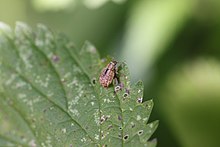Strophosoma melanogrammum
| Strophosoma melanogrammum | ||||||||||||
|---|---|---|---|---|---|---|---|---|---|---|---|---|

Strophosoma melanogrammum |
||||||||||||
| Systematics | ||||||||||||
|
||||||||||||
| Scientific name | ||||||||||||
| Strophosoma melanogrammum | ||||||||||||
| ( Forster , 1771) |
Strophosoma melanogrammum is a beetle from the family of the weevils (Curculionidae). The species lives mainly in forests and is considered, less importantly, forest pests in deciduous and coniferous crops. The species does not have an established German name, but it is variously referred to as "Schwarzfleckiger Kranzrüssler" or "Kahlnahtiger Graurüssler".
description
Strophosoma melanogrammum becomes 4 to 5.5 millimeters long. It has a broad trunk. The black wings (elytres) are covered with brown-bronze colored scales. In the middle, near the base, these scales are missing, so that a broad black line is visible. Several rows of black dots run along the wings.
Distribution and way of life
The beetle species is widespread in Europe. Forests and open areas with trees are the habitat of the beetles. The fully grown polyphagous beetles can be found on a large number of trees from the end of April: on pines , spruces and larches , on common Douglas fir and red beech , as well as on firs , birches , mountain ash and oaks . The beetles prefer to eat needles, leaves, buds and young shoots. In Denmark they cause feeding damage to the needles of Nordmann firs ( Abies nordmanniana ) and noble firs ( Abies procera ) in Christmas tree plantations and are considered to be forest pests . Strophosoma melanogrammum is a triploid species of beetle that reproduces parthenogenetically . The chromosome set is 3n = 33. The eggs are laid on the floor. The larvae hatch after 10–15 days. These stay in the ground and feed on the roots of herbaceous plants such as the stump-leaved dock ( Rumex obtusifolius ) and the wire-smear ( Deschampsia flexuosa ). Pupation takes place in August. The beetles from the previous year die in September or October. The new generation of beetles overwintered.
Similar species
The related species Strophosoma capitatum is about the same size and looks very similar to Strophosoma melanogrammum . The most important distinguishing feature is the lack of the black line in S. capitatum .
etymology
The suffix melanogrammum is derived as follows: melano = "black" ( Neo-Latin ) and gramme = "line" or "dash" ( Greek ).
literature
- Heinz joy , Karl Wilhelm Harde , Gustav Adolf Lohse (ed.): The beetles of Central Europe . tape 10 : Bruchidae – Curculionidae 1 . Goecke & Evers , Krefeld 1981, ISBN 3-87263-029-6 .
- Karl Wilhelm Harde, Frantisek Severa and Edwin Möhn: The Kosmos Käferführer: The Central European Beetles. Franckh-Kosmos Verlags-GmbH & Co KG, Stuttgart 2000, ISBN 3-440-06959-1 .
Individual evidence
- ↑ Strophosoma melanogrammum . www.kerbtier.de. Retrieved February 18, 2017.
- ↑ a b c d e Black-spotted Weevil . www.insektenbox.de. Retrieved February 18, 2017.
- ↑ a b c d Strophosoma melanogrammum . kaefer-der-welt.de. Retrieved February 18, 2017.
- ^ A b c Heinz Freude , Karl Wilhelm Harde , Gustav Adolf Lohse (ed.): Die Käfer Mitteleuropas . tape 10 : Bruchidae – Curculionidae 1 . Goecke & Evers , Krefeld 1981, ISBN 3-87263-029-6 .
- ↑ a b Strophosoma melanogrammum . www.ispotnature.org. Retrieved February 18, 2017.
- ↑ a b c d J. Urban: Strophosoma melanogrammum - a pest on young beech trees and on European mountain ash in the Zdar region, Czech Republic, 1999 . Food and Agriculture Organization of the United Nations (FAO) - AGRIS. Retrieved February 18, 2017.
- ↑ a b c d Charlotte Nielsen, Jørgen Eilenberg, Susanne Harding, Susanne Vestergaard: Biological Control of Weevils (Strophosoma melanogrammum and S. capitatum) in Greenery Plantations in Denmark . Danish Environmental Protection Agency. Retrieved February 18, 2017.
- ↑ Dorota Lachowska, Maria Rožek, Milada Holecová: New data on the cytology of parthenogenetic weevils (Coleoptera, Curculionidae). Genetica 134, 2008: 235-242 doi : 10.1007 / s10709-007-9230-x
